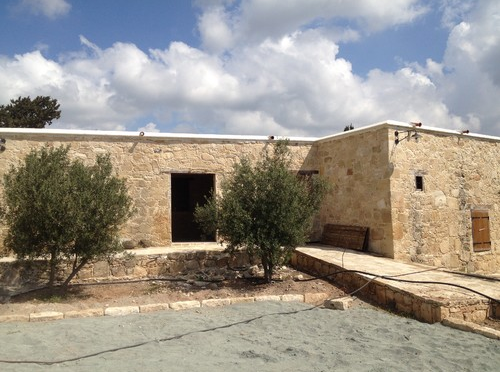
Notes from a Visit to Kouklia Village, Paphos
20 March 2015 | Philip Ammerman
I’ve been seeing pictures of Kouklia Village and particularly the Panagia Odigitria Church since I first visited Cyprus in 1993. Today I finally had the chance to see the original. It is spectacular. Notes from a visit to Kouklia.

Panagia Odigitria Church in Kouklia Village, Paphos.
Two weeks ago, Navigator started a training course for the Cyprus Chamber of Commerce and Industry on internet marketing for the tourism sector. As part of the project, consultancy visits are scheduled with each participating firm. Today it was the turn of the Liopetro Venue, an events and weddings venue located in Kouklia Village with a spectacular view over the Temple of Aphrodite (Ancient Palaipafos), the Panagia Odigitria Church and the Mediterranean Sea.
The Venue is based on the full renovation of two old farm buildings. Meticulous work is being done to build out the venue using traditional building materials and techniques. When finished, the Venue will be used for weddings (civil weddings and receptions), christenings and other events. This is a start-up venture by Makis Tsiatsos and his wife, and their attention to detail is a welcome promise of future success.
Just across the street from the Venue is the Panagia Odigitria Church. This church sparked an instant recognition, because I’ve seen it on so many brochures or reports dealing with Cyprus. Looking back as I write this article, I remember how the Cyprus Tourism Organisation was promoting the idea of rural tourism and cultural heritage back in 1993, and how the village of Kouklia featured heavily in this.
According to the Kouklia Village Council, the Church was built in 1240 on the site of a “pagan temple”, and was dedicated to the Virgin Mary (“Panagia Odigitria”).
Kouklia itself is the site of Palaipafos. According to the About Cyprus website, it was continuously inhabited since the Chalcolithic period:
Tradition refers to Kinyras, the legendary Cypriot king, as the founder and first High Priest of the sanctuary. Another legend mentions Agapenor, the King of Tegea in Arcadia in Greece, as the founder of the city and sanctuary.
Although the site was continuously inhabited from the Chalcolithic period to the present day, its most important period is the end of the Late Bronze Age, when Mycenaean Greeks settled there ca 1200 BC.
According to legend, Pafos was one of the city-Kingdoms of Cyprus established by heroes after the end of the Trojan War. In an 11th century BC tomb at Palaepafos a bronze skewer was found, bearing the engraved Greek name "Opheltis"; this is the earliest evidence for the use of the Greek language in Cyprus.
The sanctuary of Aphrodite, built in the 12th century BC., indicates a deeply-rooted tradition of a fertility cult. The sanctuary was continuously in use until the end of the Roman period.
In September 1980, Palaipafos and Nea Pafos became the first Cypriot sites to be included in the World Heritage List of UNESCO.
According to Wikipedia:
A temple was never built for the goddess. Instead, the holy altar stood in the open air, encircled by walls and fitted with brightly coloured doors, according to Homer. She was not worshipped as a statue, but rather in the form of conical stone. The ancients report it as something strange, "a white pyramid which the material is not known". This symbolic stone existed at Paphos from ancient times and, as the adoration of standing stones is a feature of eastern religions, the nearby Petra tou Romiou (Aphrodite's rock) may be responsible for the creation of the myth that she was born here.
The sanctuary was dedicated to Aphrodite, known to our Roman cousins as Venus. It's interesting that Kinyras was the founder and high priest of Aphrodite, towards the end of the Mycenaean age / Helladic period, just as four prominent Romans claimed a connection to Venus at the end of the Republic a thousand years later: Sulla (Venus Felix); Pompey (Temple of Venus Vitrix); Julius Caesar (who claimed a direct link); and Hadrian (temple to Venus and Roma Aeterna).
Sadly, there was no time to visit the ancient site. But the juxtaposition of a ruined Temple of Aphrodite with this amazing church of the Virgin Mary, with the Lusignan Manor House serving as an anchor to the southern end of the site, was really impressive. The Manor House now serves as the area’s Archaeological Museum.
Without further ado – photos from Kouklia.

View of Panagia Odigitisa Church from the East / The Apse

View from the South West

Detail of Two Arches

Water Spout - Shaped like a Pig?

Liopetro Venue - The main plaza. The two buildings have been renovated using traditional building methods and materials.

Liopetro Venue - Office and Reception Area.

Liopetro Venue - Planting Trees. The building in the distance is the Lusignan Manor House that today houses the Archaeological Museum.

Horses overlooking the sea
